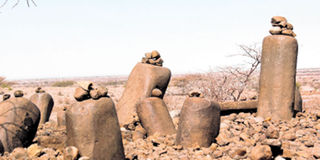At Namoratunga, the devil is said to have turned men into stones

The leaning pillars at Kalokol. Storms, groundwater, and erosion have weathered some of the pillars, making them look like men standing in the plains of Turkana County. PHOTO | CORRESPONDENT
What you need to know:
- The site has 19 magnetic basalt pillars, each with four facets and an inclined top.
- Their bases are littered with about 20,000 stones — probably more because visitors usually leave stones there.
- The pillars lean in different directions and this has generated a myth that they were once men, petrified by the devil after failing their tests.
The “dancing stones” of Namoratunga look innocuous from a distance. However, behind their simplicity lies a great story about the origin of man.
The stones, also referred to as Namoratunga Two or the Kalokol Pillar Site, mark the first archaeological site in Sub-Saharan Africa.
Yet, from a distance, they do not look much different from the sacks of charcoal that sold on the roadsides in Turkana.
Namoratunga in Turkana means “stone people”. The site is marked by a circle of stones that according to estimates has been there since 300 BC.
Once men
The site has 19 magnetic basalt pillars, each with four facets and an inclined top. Their bases are littered with about 20,000 stones — probably more because visitors usually leave stones there.
The pillars lean in different directions and this has generated a myth that they were once men, petrified by the devil after failing their tests.
The tests, so the story goes, were simple. The devil would sing a song and if anyone showed any emotion, he would be turned into a stone.
According to the myth, one chief had successfully managed to outwit the devil. However, just when he thought that he had escaped the devil’s trap, he smiled and the devil claimed him too.
That chief is believed to be the upright pillar and the tilted pillars are the first people to be turned into stones. In December, the site usually hosts major gatherings of Turkana clans, which go to seek divine intervention in matters affecting them socially or economically.
Throughout the rest of the year, it attracts both local and international visitors.
The site, which has baffled laymen and archaeologists alike, is in Turkana Central Sub-County, just 50 metres off the Lodwar-Kalokol road.
It is easy for the visitor to miss it, but considering its importance to the story of mankind, it would be a good idea not to.




